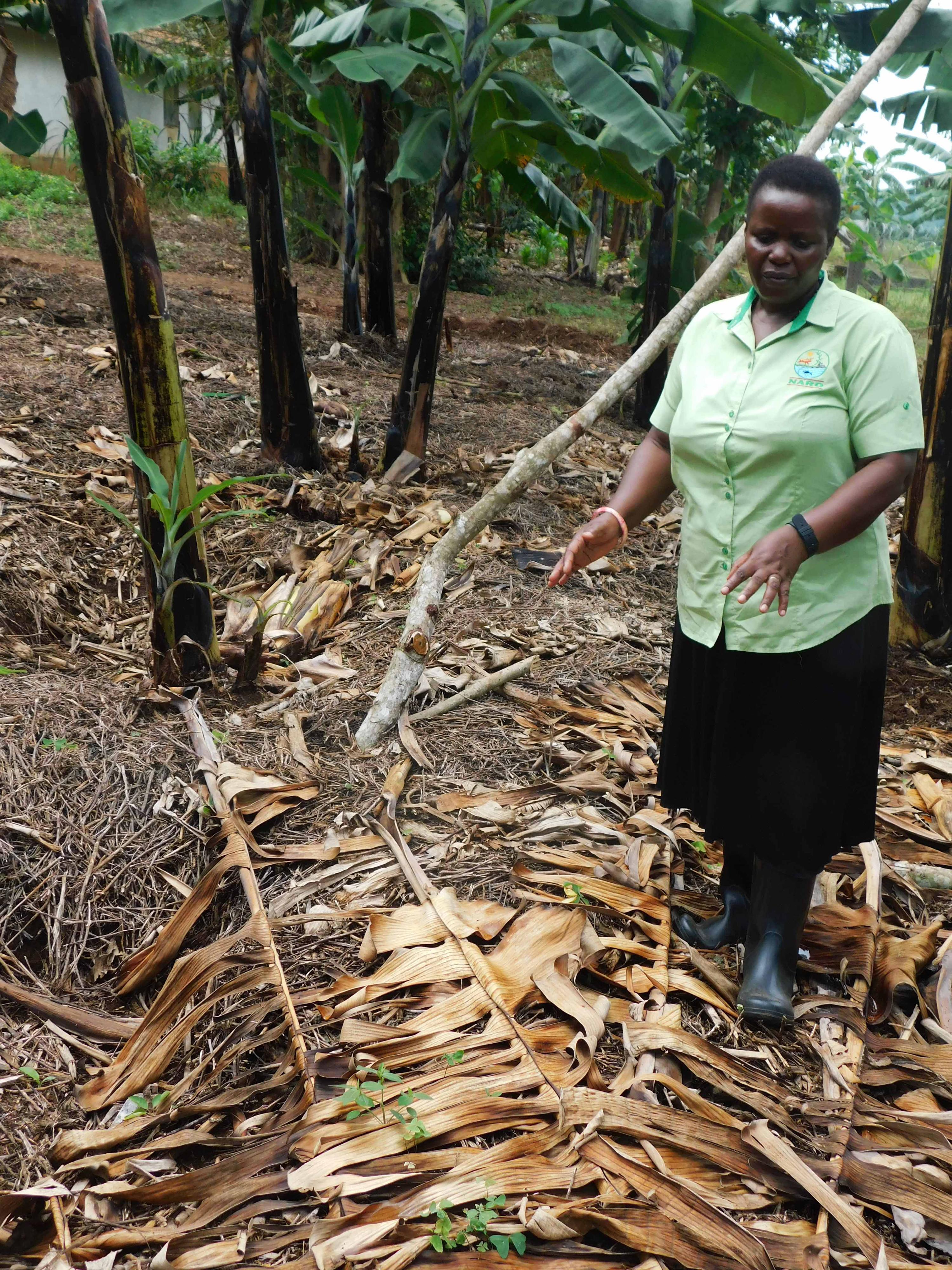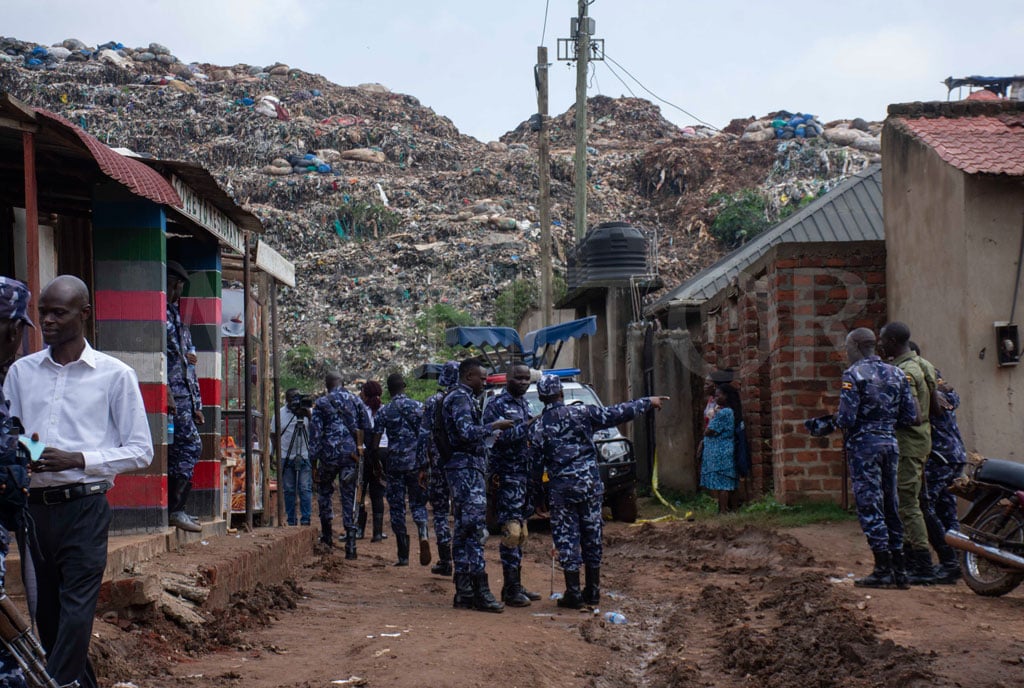
Winfred says mulching keeps the soil in the banana plantation moist. Photo/Michael J Ssali
|Farming
Prime
Taking the best care of a banana garden
What you need to know:
- Suckers measuring about three feet should be taken from high yielding and healthy mother plants completely free from pests and diseases.
- Bananas do well in areas where rainfall is well distributed throughout the year and farmers must do their best to preserve water in the soil by mulching with grass, crop residues, dry banana leaves and split banana stems.
Some 47 percent of agricultural households in Uganda grow bananas on a land area of 579,000 hectares, according to the Annual Agricultural Survey 2018 Statistical Release.
In that year Uganda’s banana total production was 6.5 million tonnes, grown in western, central and some parts of the east.
Main food crop
Bananas are the main food crop in the central region but it is widely consumed in many other parts of Uganda. Uganda is the most important producer of the crop in Africa and only second to India in the world.
As we take pride in being the leading producers of bananas, which is locally referred to as matooke, production of the crop is not as big as it should be since the demand clearly appears to be more than supply as the price of matooke keeps rising all the time.
Statistics
Anybody who seriously takes up banana farming will not regret it because the market is very big and hard to satisfy.
However it is under attack by a number of pests and, due to land fragmentation, fast increasing population, and poor agronomical practices, production is not as good as it ought to be especially in much of the Central region, where ironically matooke is the staple food crop.
According to the Uganda Census of Agriculture 2008/2009 by Uganda Bureau of Statistics the central region’s banana production stood at 1,039,837 metric tonnes from 326,082 hectares under the crop while western region’s production was at 2,883,48 metric tonnes from 511,096 hectares.
Isingiro in particular, which alone produced 601,363 metric tonnes, was the leading banana producer district in the entire country. Massive banana production is slowly shifting to western Uganda.
Poor management
Winfred N Nakyagaba Sserwanga, crop agronomist at Mukono Zonal Agricultural Research Development Institute (MUZARDI) Kamenyamiggo Satellite agrees that banana production in the central region has greatly reduced.
She attributes the decline to poor management of the crop and declining soil fertility. “Successful banana farming mainly depends on water and soil fertility,” she says.
“That is why at our demonstration plantation at Kamenyamiggo we do a lot of mulching and trapping of running rainwater by digging galleys that lead the water into the plantation. What the farmers in the region ought to do is to restore soil fertility and to fight pests and diseases.”
Kamenyamiggo Satellite which is located in Lwengo District is the place for farmers in Masaka region to go for picking good farming practices.
Proper agronomy
Planting
Winfred is in charge of a well sustained banana plantation at the institute where farmers go to gain more information about banana field maintenance.
She says the farmer should begin with choosing clean planting material. At Kamenyamiggo banana plantation, disease and pest free suckers for planting are available at a small cost each.
She however said that even farmers who want to plant tissue culture banana plantlets can be assisted by the institute to acquire them.
“Planting should be done at the beginning of the rainy season,” she said.
She added, “Bananas do well in areas where rainfall is well distributed throughout the year and farmers must do their best to preserve water in the soil by mulching with grass, crop residues, dry banana leaves and split banana stems. This practice keeps the soil moist and suppresses weed growth. It also mitigates soil erosion and adds organic manure when the mulch material decomposes.”
Mulching
She went on to say that much as mulching helps to sustain moisture in the soil farmers should endeavour to dig galleys across the banana plantation to trap running rainwater.
She also encourages farmers working near roads to trap roadside running rainwater by digging galleys to lead that water into the banana plantation.
Different banana cultivars or varieties are grown in Uganda including mpologoma, kibuzi, nakitembe, nakinnyika, nakabululu, nambi, muvubo, mbwazirume among others. The farmer should decide on what varieties he or she intends to grow.
Suckers measuring about three feet should be taken from high yielding and healthy mother plants completely free from pests and diseases.
For farmers who prefer tissue culture plantlets it is possible to decide which variety that one needs to plant.
“We are well linked with laboratories that prepare tissue culture plantlets and we can assist the farmers to get them,” said Winfred.
“They should be planted into holes dug well before and filled up with soil that is mixed with compost or livestock manure.”
Spacing of about ten feet by ten feet is recommended between plants.
Tissue culture plantlets are relatively a new phenomenon but they are entirely disease and pest free as planting material. This is not to say that they are disease resistant.
Pests and disease control
Even farmers who plant them must guard against pests and diseases. Getting banana planting material from a reliable source such as an Agricultural Institute guarantees minimum chances of crop disease attack.
“For example right now we have suckers that are resistant to fusarium wilt which is locally referred to as toduula,” she said.
Winfred further said that the farmer must strictly guard against pests by taking care not to extend mulch material such as grass or leaves too close to the banana stem.
“When all the ground around the stem is covered a good environment for pest eruption is created and also the roots of the banana plant are drawn towards the soil surface which leads to the weak growth and possible death of the banana plant. Banana plants infested with weevils tend to be yellow and weak. They are far more easily felled by strong wind.”
Winfred says that a banana rootstock may produce a lot of suckers but the farmer is responsible for sustaining just a small number of suckers.
“There should be one tall banana plant (stool) and a shorter one and then a much shorter one,” she said. Some agriculturalists refer to this as “a mother, a daughter, and a granddaughter.”
There are lots of benefits for the farmer if regular pruning is carried out including big bunches, and reduced risk of pest attack.
Soil fertility and pruning
Often a banana plantation may suffer from its own success. If the soil fertility and pruning is well taken care of there will be big, heavy, bunches that may be too much for the fruit bearing suckers to hold.
The farmer may then have to acquire forked poles to support the banana trees bearing the heavy bunches or else they will fall to the ground before the fruit is ready for harvesting.
Strong winds can be destructive to banana plantations and farmers are advised to seek guidance from agriculture officers and extension workers about planting trees in the banana plantation to protect it from the ravages of rainstorms.
Winfred also said that if farmers carefully carry out good farming practices there will be much less risk for pest attack and disease.
“To avoid spreading such diseases as Banana Bacterial Wilt we require the man working in our banana plantation to use only one knife, one panga and one hoe,” she said. “We don’t allow any outsider to come to our plantation with any tool or sharp object. One of the worst practices that spread Banana Bacterial Wilt is mindless usage of sharp tools like pangas, knives, and hoes.”
Recommendations
Winfred said it may not be possible to avoid pests always but many farmers these days have devised organic pesticides which she referred to as “bio-rational”.
However she recommended the use of dudu-guard as a good chemical alternative for fighting most common banana pests.
She also said it is important for the farmer to carefully follow the manufacturer’s instructions for using the pesticide.
As much as possible any use of agro-chemicals by farmers should be based on advice from the area agricultural extension officer.
Statistics
According to the Uganda Census of Agriculture 2008/2009 by Uganda Bureau of Statistics the central region’s banana production stood at 1,039,837 metric tonnes from 326,082 hectares under the crop while western region’s production was at 2,883,48 metric tonnes from 511,096 hectares.
Isingiro in particular, which alone produced 601,363 metric tonnes, was the leading banana producer district in the entire country.




